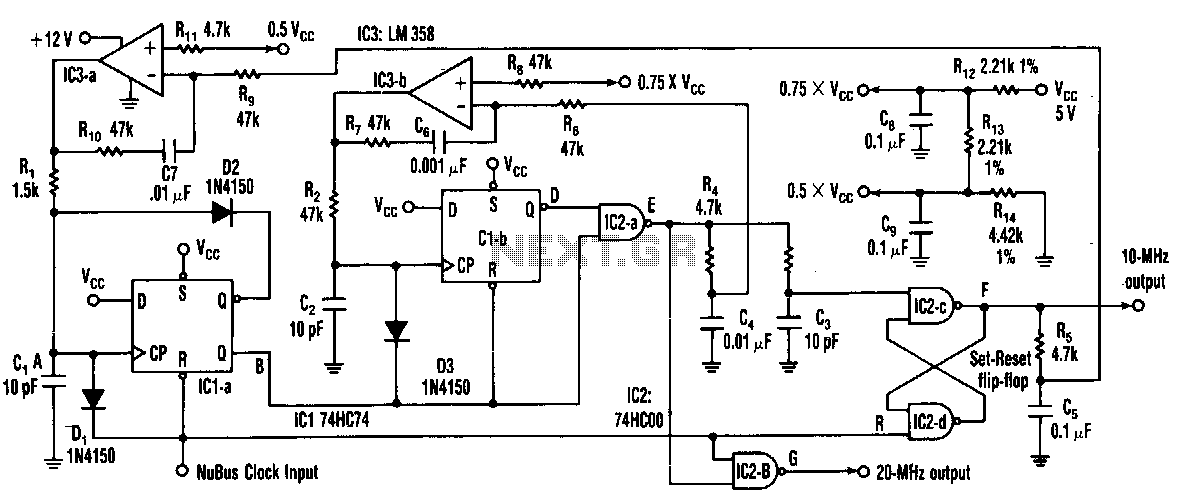
Up-down-counter

The discrete-gate up/down-counter design has the unusual property of freezing, or saturating, when it reaches its lowest count in the down-count mode or its highest count in the count-up mode instead of rolling over and resetting as do most counters. This property proves especially useful in position-control systems. For example, you wouldn't want a robot's arm to slowly move to full extension as the counter counts up and then have it suddenly slam back to its rest position when the counter resets to zero. More: You can cascade as many of the A cells as you need because the counter's outputs are synchronous. The B cell accepts the carry bit from the most significant bit's A cell and provides the clock control that stops the counter. Make sure that the freeze input to the B cell doesn't get asserted when the clock input is low; otherwise, the counter might make an extra count.
The discrete-gate up/down-counter is a digital circuit designed to count in both ascending and descending order, offering a unique operational feature where the counter freezes at its maximum and minimum count values. This characteristic is particularly advantageous in applications requiring precise control, such as robotic systems, where abrupt changes in position can lead to mechanical stress or damage.
The architecture comprises two primary components, referred to as A cells and a B cell. The A cells function as the fundamental counting units, capable of incrementing or decrementing the count based on the input signals. These cells are synchronized, allowing for cascading multiple units to achieve higher counting ranges without losing timing integrity. The synchronous nature of the outputs ensures that all A cells update their states simultaneously, which is crucial for maintaining accurate counts in multi-stage configurations.
The B cell serves a dual purpose: it processes the carry bit from the most significant A cell and manages the clock signal that governs the counting operation. This cell is integral to the freezing mechanism, as it controls the conditions under which the counter can advance. To maintain proper functionality, it is essential that the freeze input to the B cell remains inactive when the clock input is low. If the freeze condition is asserted during this period, it could inadvertently cause the counter to register an additional count, leading to potential inaccuracies in the system.
In summary, the discrete-gate up/down-counter is designed for applications where precise control is critical, allowing for smooth transitions between counting states without the risk of undesired resets. The cascading capability of the A cells combined with the control provided by the B cell enhances its usability in complex electronic systems.The discrete-gate up/down-counter design has the unusual property of freezing, or saturating, when it reaches its lowest count in the down-count mode or its highest count in the count-up mode instead of rolling over and resetting as do most counters. This property proves especial!y useful in position-control systems. For example, you wouldn"t want a robot"s arm to slowly move to full extension as the counter counts up and then have it suddenly slam back to its rest position when the counter resets to zero.
🔗 External reference
The discrete-gate up/down-counter is a digital circuit designed to count in both ascending and descending order, offering a unique operational feature where the counter freezes at its maximum and minimum count values. This characteristic is particularly advantageous in applications requiring precise control, such as robotic systems, where abrupt changes in position can lead to mechanical stress or damage.
The architecture comprises two primary components, referred to as A cells and a B cell. The A cells function as the fundamental counting units, capable of incrementing or decrementing the count based on the input signals. These cells are synchronized, allowing for cascading multiple units to achieve higher counting ranges without losing timing integrity. The synchronous nature of the outputs ensures that all A cells update their states simultaneously, which is crucial for maintaining accurate counts in multi-stage configurations.
The B cell serves a dual purpose: it processes the carry bit from the most significant A cell and manages the clock signal that governs the counting operation. This cell is integral to the freezing mechanism, as it controls the conditions under which the counter can advance. To maintain proper functionality, it is essential that the freeze input to the B cell remains inactive when the clock input is low. If the freeze condition is asserted during this period, it could inadvertently cause the counter to register an additional count, leading to potential inaccuracies in the system.
In summary, the discrete-gate up/down-counter is designed for applications where precise control is critical, allowing for smooth transitions between counting states without the risk of undesired resets. The cascading capability of the A cells combined with the control provided by the B cell enhances its usability in complex electronic systems.The discrete-gate up/down-counter design has the unusual property of freezing, or saturating, when it reaches its lowest count in the down-count mode or its highest count in the count-up mode instead of rolling over and resetting as do most counters. This property proves especial!y useful in position-control systems. For example, you wouldn"t want a robot"s arm to slowly move to full extension as the counter counts up and then have it suddenly slam back to its rest position when the counter resets to zero.
You can cascade as many of the A cells as you need because the counter"s outputs are synchronous. The B cell accepts the carry bit from the most sigoificant bit. s A cell and provides the clock control that stops the counter. Make sure that the freeze input to the B cell doesn"t get asserted when the clock input is low; otherwise, the counter might make an extra count.
🔗 External reference
Warning: include(partials/cookie-banner.php): Failed to open stream: Permission denied in /var/www/html/nextgr/view-circuit.php on line 713
Warning: include(): Failed opening 'partials/cookie-banner.php' for inclusion (include_path='.:/usr/share/php') in /var/www/html/nextgr/view-circuit.php on line 713
